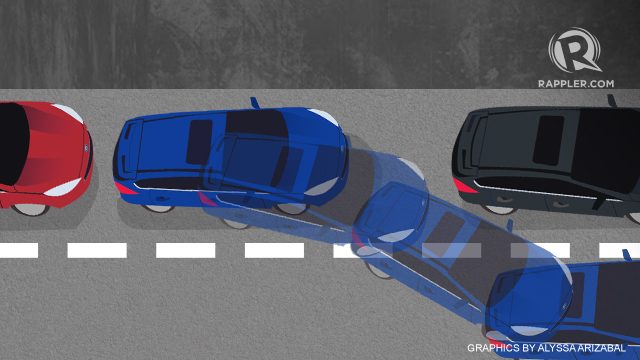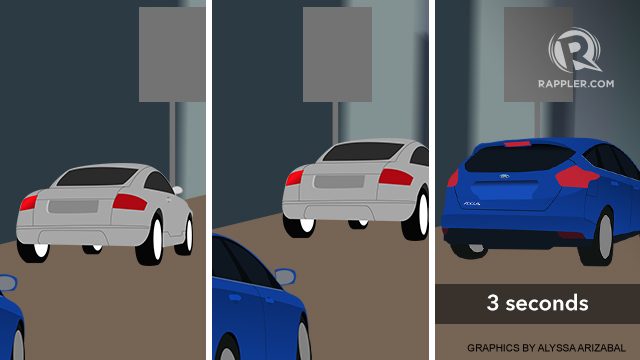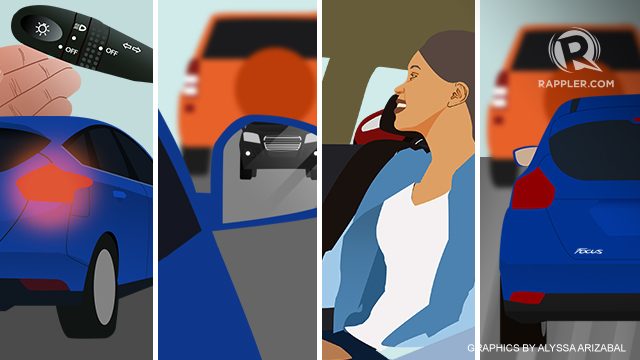SUMMARY
This is AI generated summarization, which may have errors. For context, always refer to the full article.

MANILA, Philippines – If you’re wondering what bad driving habits are, just take a quick look out your window the next time you’re on the road: cars swerving left and right, fender benders caused by tailgating, and poorly parked cars taking up precious road space are just a few of the things that you might encounter.
A driver with bad habits is a hazard to every other person on the road. In the Philippines, statistics indicate that driver errors are responsible for roughly 79% of road crash fatalities.
While vehicles today are packed with smarter features to increase safety (READ: Driving in the modern world), a car is only as smart as the person behind the wheel. Smart driving starts with good habits.
Follow these step-by-step guides whenever you’re behind the wheel until they become habits that stick for good.
Perfect the art of parallel parking
If the idea of parallel parking is enough to make you anxious, you’re not alone; around 27% of Filipinos admit to finding to finding it stressful.
But knowing how to parallel park isn’t just handy for getting the last free spot on a busy street. A proper parking job can safeguard your car from getting sideswiped, which also saves you from having to file an insurance claim or being the victim of a hit-and-run.
While some cars are now equipped with a feature that automatically parallel parks your car for you, nothing beats knowing the basics. Here’s a simple method on how to park in just a few steps:
- Line your car up next to the car in front of the empty slot, with about 2-3 feet of room in between.
- Start reversing. When the middle of your car is in line with the back tires of the parked car, turn the steering wheel all the way in the direction you want to park.
- When your car is about 45-degrees to the car in front, turn the steering wheel the other way fully while continuing to reverse.
- Once your rear bumper is roughly in line with the car behind you, make a few small adjustments to even everything out.
Keep a safe distance while moving
It’s common sense that keeping a safe distance from other vehicles can help you avoid an accident. While some cars today have an emergency automatic braking system in place for low-speed collisions, prevention is always safer than reaction. Keep a distance of at least one car length or more between you and the car in front while you’re moving.
But measuring the distance between two moving objects can be pretty tricky, especially when you’re focused on everything else on the road. Luckily, there’s the simple time-lapse method.
- Pick a landmark on the side of the road, like a light post or a street sign.
- When the car in front passes the landmark, count how many seconds it takes before your car passes the same spot.
- Ideally, at least 3-seconds should pass between the time that the first car passes the landmark to when you pass the same spot. This is how you can gauge if you’re keeping a safe distance.
Merge mindfully
While swerving isn’t a traffic violation, it still presents a danger to you and everyone else on the road. Changing lanes without indicating or checking if it’s safe is a risky habit that could lead to disaster.
Modern features like blind spot detectors on your side mirrors can help when you’re changing lanes (READ: 6 ways to upgrade your driving skills), but the safest bet is to always double-check. To stay safe while merging, always keep the S.M.O.G. rule in mind:
- Signal – Switch your turn signal on in the direction where you want to change lanes
- Mirrors – Check your mirrors to make sure that the next lane is clear
- Over the shoulder – Do a quick glance over you shoulder to double-check
- Go – When the coast is clear, then you can change lanes
Being a smart driver is more than just knowing your car’s capabilities and features. Smart driving is built on common sense, alertness and awareness – habits that are built over time. Make the streets safer by perfecting these steps until they become second nature – because one safe driver behind the wheel creates a big impact on the rest of the road. – Rappler.com
Add a comment
How does this make you feel?

There are no comments yet. Add your comment to start the conversation.